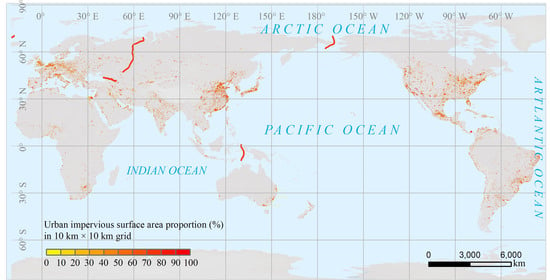Mapping Global Urban Impervious Surface and Green Space Fractions Using Google Earth Engine
Abstract
:1. Introduction
2. Materials and Methods
2.1. The Principle and Strategies for Developing Urban ISA and GS Products
2.1.1. The Hierarchical Architecture Principle and Subpixel Metric Method
2.1.2. The Mapping Strategies for ISA and GS Products
2.1.3. Data Collection and Preprocessing
2.2. Mapping Global Urban ISA and GS Using GEE
2.2.1. Retrieval of NSDI and NGSI
2.2.2. Mapping Urban Boundaries Based on NSDI
2.2.3. Mapping Global Urban ISA and GS Fractions
2.2.4. Accuracy Assessment
3. Results
3.1. Performance and Accuracy of Ubran ISA and GS Fractions
3.2. Distribution and Spatial Heterogenity of Global Urban ISA and GS
3.3. Comparison with Other Existing Datasets
4. Discussion
4.1. Advantages of the Methods and Algorithms Used to Map Urban ISA and GS Products
4.2. Potential Implications for Improving Urban Environments and Assessments of Sustainable Cities
5. Conclusions
Supplementary Materials
Author Contributions
Funding
Institutional Review Board Statement
Informed Consent Statement
Data Availability Statement
Acknowledgments
Conflicts of Interest
References
- Grimm, N.B.; Faeth, S.H.; Golubiewski, N.E.; Redman, C.L.; Wu, J.; Bai, X.; Briggs, J.M. Global change and the ecology of cities. Science 2008, 319, 756–760. [Google Scholar] [CrossRef] [PubMed] [Green Version]
- Gao, J.; O’Neill, B.C. Mapping global urban land for the 21st century with data-driven simulations and shared socioeconomic pathways. Nat. Commun. 2020, 11, 2302. [Google Scholar] [CrossRef] [PubMed]
- Seto, K.C.; Golden, J.S.; Alberti, M.; Turner, B.L., II. Sustainability in an urbanizing planet. Proc. Natl. Acad. Sci. USA 2017, 114, 8935–8938. [Google Scholar] [CrossRef] [PubMed] [Green Version]
- Acuto, M.; Parnell, S.; Seto, K.C. Building a global urban science. Nat. Sustain. 2018, 1, 2–4. [Google Scholar] [CrossRef]
- Turner, B.L., II. Land system architecture for urban sustainability: New directions for land system science illustrated by application to the urban heat island problem. J. Land Use Sci. 2016, 11, 689–697. [Google Scholar] [CrossRef]
- Jacobson, C.R. Identification and quantification of the hydrological impacts of imperviousness in urban catchments: A review. J. Environ. Manag. 2011, 92, 1438–1448. [Google Scholar] [CrossRef] [PubMed]
- Kuang, W.H.; Dou, Y.Y.; Zhang, C.; Chi, W.F.; Liu, A.L.; Liu, Y.; Zhang, R.H.; Liu, J.Y. Quantifying the heat flux regulation of metropolitan land use/land cover components by coupling remote sensing modeling with in situ measurement. J. Geophys. Res.-Atmos. 2015, 120, 113–130. [Google Scholar] [CrossRef]
- Yan, Y.; Kuang, W.H.; Zhang, C.; Chen, C.B. Impacts of impervious surface expansion on soil organic carbon: A spatially explicit study. Sci. Rep. 2015, 5, 17905. [Google Scholar] [CrossRef] [Green Version]
- Gong, P.; Li, X.C.; Wang, J.; Bai, Y.; Chen, B.; Hu, T.; Liu, X.; Xu, B.; Yang, J.; Zhang, W.; et al. Annual maps of global artificial impervious area (GAIA) between 1985 and 2018. Remote Sens. Environ. 2020, 236, 111510. [Google Scholar] [CrossRef]
- Seto, K.C.; Guneralp, B.; Hutyra, L.R. Global forecasts of urban expansion to 2030 and direct impacts on biodiversity and carbon pools. Proc. Natl. Acad. Sci. USA 2012, 109, 16083–16088. [Google Scholar] [CrossRef] [Green Version]
- Bren d’Amour, C.; Reitsma, F.; Baiocchi, G.; Barthel, S.; Güneralp, B.; Erb, K.-H.; Haberl, H.; Creutzig, F.; Seto, K.C. Future urban land expansion and implications for global croplands. Proc. Natl. Acad. Sci. USA 2017, 114, 8939–8944. [Google Scholar] [CrossRef] [PubMed] [Green Version]
- Li, X.Y.; Kuang, W.H.; Sun, F.Y. Identifying urban flood regulation priority areas in Beijing based on an ecosystem services approach. Sustainability 2020, 12, 2297. [Google Scholar] [CrossRef] [Green Version]
- Kuang, W.H. Mapping global impervious surface area and green space within urban environments. Sci. China Earth Sci. 2019, 62, 1591–1606. [Google Scholar] [CrossRef]
- Dong, J.W.; Kuang, W.H.; Liu, J.Y. Continuous land cover change monitoring in the remote sensing big data era. Sci. China Earth Sci. 2017, 60, 2223–2224. [Google Scholar] [CrossRef]
- Feng, M.; Li, X. Land cover mapping toward finer scales. Sci. Bull. 2020, 65, 1604–1606. [Google Scholar] [CrossRef]
- Gong, J.; Liu, C.; Huang, X. Advances in urban information extraction from high-resolution remote sensing imagery. Sci. China Earth Sci. 2020, 63, 463–475. [Google Scholar] [CrossRef]
- Elvidge, C.D.; Tuttle, B.T.; Sutton, P.S.; Baugh, K.E.; Howard, A.T.; Milesi, C.; Bhaduri, B.L.; Nemani, R. Global distribution and density of constructed impervious surfaces. Sensors 2007, 7, 1962–1979. [Google Scholar] [CrossRef]
- Schneider, A.; Friedl, M.A.; Potere, D. A new map of global urban extent from MODIS satellite data. Environ. Res. Lett. 2009, 4, 044003. [Google Scholar] [CrossRef] [Green Version]
- Schneider, A.; Friedl, M.A.; Potere, D. Mapping global urban areas using MODIS 500 m data: New methods and datasets based on “urban ecoregions”. Remote Sens. Environ. 2010, 114, 1733–1746. [Google Scholar] [CrossRef]
- Zhou, Y.Y.; Li, X.C.; Asrar, G.R.; Smith, S.J.; Imhoff, M. A global record of annual urban dynamics (1992–2013) from nighttime lights. Remote Sens. Environ. 2018, 219, 206–220. [Google Scholar] [CrossRef]
- He, C.Y.; Liu, Z.F.; Gou, S.Y.; Zhang, Q.F.; Zhang, J.S.; Xu, L.L. Detecting global urban expansion over the last three decades using a fully convolutional network. Environ. Res. Lett. 2019, 14, 034008. [Google Scholar] [CrossRef]
- Esch, T.; Marconcini, M.; Felbier, A.; Roth, A.; Heldens, W.; Huber, M.; Schwinger, M.; Taubenböck, H.; Müller, A.; Dech, S. Urban footprint processor—Fully automated processing chain generating settlement masks from global data of the TanDEM-X mission. IEEE Geosci. Remote Sens. Lett. 2013, 10, 1617–1621. [Google Scholar] [CrossRef] [Green Version]
- Pesaresi, M.; Huadong, G.; Blaes, X.; Ehrlich, D.; Ferri, S.; Gueguen, L.; Halkia, M.; Kauffmann, M.; Kemper, T.; Lu, L.; et al. A global human settlement layer from optical HR/VHR RS data: Concept and first results. IEEE J. Sel. Top. Appl. Earth Obs. Remote Sens. 2013, 6, 2102–2131. [Google Scholar] [CrossRef]
- Chen, J.; Chen, J.; Liao, A.P.; Cao, X.; Chen, L.J.; Chen, X.H.; He, C.Y.; Han, G.; Peng, S.; Lu, M.; et al. Global land cover mapping at 30 m resolution: A POK-based operational approach. ISPRS J. Photogramm. 2015, 103, 7–27. [Google Scholar] [CrossRef] [Green Version]
- Liu, X.P.; Hu, G.H.; Chen, Y.M.; Li, X.; Xu, X.C.; Li, S.Y.; Pei, F.S.; Wang, S.J. High-resolution multi-temporal mapping of global urban land using Landsat images based on the Google Earth Engine Platform. Remote Sens. Environ. 2018, 209, 227–239. [Google Scholar] [CrossRef]
- Liu, X.P.; Huang, Y.H.; Xu, X.C.; Li, X.C.; Li, X.; Ciais, P.; Lin, P.R.; Gong, K.; Ziegler, A.D.; Chen, A.P.; et al. High-spatiotemporal-resolution mapping of global urban change from 1985 to 2015. Nat. Sustain. 2020, 3, 564–570. [Google Scholar] [CrossRef]
- Zhang, X.; Liu, L.Y.; Wu, C.S.; Chen, X.D.; Gao, Y.; Xie, S.; Zhang, B. Development of a global 30 m impervious surface map using multisource and multitemporal remote sensing datasets with the Google Earth Engine platform. Earth Syst. Sci. Data 2020, 12, 1625–1648. [Google Scholar] [CrossRef]
- Li, X.C.; Gong, P.; Zhou, Y.Y.; Wang, J.; Bai, Y.Q.; Chen, B.; Hu, T.; Xiao, Y.X.; Xu, B.; Yang, J.; et al. Mapping global urban boundaries from the global artificial impervious area (GAIA) data. Environ. Res. Lett. 2020, 15, 094044. [Google Scholar] [CrossRef]
- Wang, P.S.; Huang, C.Q.; Brown de Colstoun, E.C.; Tilton, J.C.; Tan, B. Global Human Built-Up and Settlement Extent (HBASE) Dataset from Landsat; NASA Socioeconomic Data and Applications Center (SEDAC): Palisades, NY, USA, 2017. [Google Scholar] [CrossRef]
- Ludwig, C.; Hecht, R.; Lautenbach, S.; Schorcht, M.; Zipf, A. Mapping public urban green spaces based on OpenStreetMap and Sentinel-2 imagery using belief functions. ISPRS Int. J. Geo-Inf. 2021, 10, 251. [Google Scholar] [CrossRef]
- Bossard, M.; Feranec, J.; Otahel, J. CORINE Land Cover Technical Guide: Addendum 2000; European Environment Agency: Copenhagen, Denmark, 2000. [Google Scholar]
- Seifert, F.M. Improving urban monitoring toward a European urban atlas. In Global Mapping of Human Settlement: Experiences, Datasets, and Prospects; CRC Press: Boca Raton, FL, USA, 2009; pp. 231–248. [Google Scholar]
- The Trust for Public Land. Available online: https://www.tpl.org/parkserve (accessed on 12 April 2021).
- Feltynowski, M.; Kronenberg, J.; Bergier, T.; Kabisch, N.; Laszkiewicz, E.; Stronhbach, M.W. Challenges of urban green space management in the face of using inadequate data. Urban For. Urban Green. 2018, 31, 56–66. [Google Scholar] [CrossRef]
- Tigges, J.; Lakes, T.; Hostert, P. Urban vegetation classification: Benefits of multitemporal RapidEye satellite data. Remote Sens. Environ. 2013, 136, 66–75. [Google Scholar] [CrossRef]
- Lu, D.S.; Moran, E.; Hetrick, S. Detection of impervious surface change with multitemporal Landsat images in an urban-rural frontier. ISPRS J. Photogramm. 2011, 66, 298–306. [Google Scholar] [CrossRef] [PubMed] [Green Version]
- Reba, M.; Seto, K. A systematic review and assessment of algorithms to detect, characterize, and monitor urban land change. Remote Sens. Environ. 2020, 242, 111739. [Google Scholar] [CrossRef]
- Kuang, W.H.; Chi, W.F.; Lu, D.S.; Dou, Y.Y. A comparative analysis of megacity expansions in China and the U.S.: Patterns, rates and driving forces. Landsc. Urban Plan. 2014, 132, 121–135. [Google Scholar] [CrossRef]
- Kuang, W.H.; Yang, T.R.; Liu, A.L.; Zhang, C.; Lu, D.S.; Chi, W.F. An EcoCity model for regulating urban land cover structure and thermal environment: Taking Beijing as an example. Sci. China Ser. D-Earth Sci. 2017, 60, 1098–1109. [Google Scholar] [CrossRef]
- Kuang, W.H. National urban land-use/cover change since the beginning of the 21st century and its policy implications in China. Land Use Policy 2020, 97, 104747. [Google Scholar] [CrossRef]
- Walton, J.T. Subpixel urban land cover estimation: Comparing cubist, random forests, and support vector regression. Photogramm. Eng. Remote Sens. 2008, 10, 1213–1222. [Google Scholar] [CrossRef] [Green Version]
- Reschke, J.; Hüttich, C. Continuous field mapping of Mediterranean wetlands using sub-pixel spectral signatures and multi-temporal Landsat data. Int. J. Appl. Earth Obs. 2014, 28, 220–229. [Google Scholar] [CrossRef]
- Huang, X.; Schneider, A.; Friedl, M. A Mapping sub-pixel urban expansion in China using MODIS and DMSP/OLS nighttime lights. Remote Sens. Environ. 2016, 175, 92–108. [Google Scholar] [CrossRef]
- Tsutsumida, N.; Comber, A.; Barrett, K.; Saizen, I.; Rustiadi, E. Sub-pixel classification of MODIS EVI for annual mappings of impervious surface areas. Remote Sens. 2016, 8, 143. [Google Scholar] [CrossRef] [Green Version]
- Zhao, Y.; Zhong, K.W.; Xu, J.H.; Sun, C.; Wang, Y.P. Directional analysis of urban expansion based on sub-pixel and regional scale: A case study of main districts in Guangzhou, China. Chin. Geogr. Sci. 2019, 29, 652–666. [Google Scholar] [CrossRef] [Green Version]
- Li, L.Y.; Chen, Y.; Xu, T.B.; Meng, L.K.; Huang, C.; Shi, K.F. Spatial Attraction Models Coupled with Elman Neural Networks for Enhancing Sub-Pixel Urban Inundation Mapping. Remote Sens. 2020, 13, 2068. [Google Scholar] [CrossRef]
- Patidar, N.; Keshari, A.K. A rule-based spectral unmixing algorithm for extracting annual time series of sub-pixel impervious surface fraction. Int. J. Remote Sens. 2020, 10, 3970–3992. [Google Scholar] [CrossRef]
- Xian, G.; Shi, H.; Dewitz, J.; Wu, Z.T. Performances of WorldView 3, Sentinel 2, and Landsat 8 data in mapping impervious surface. Remote Sens. Appl. Soc. Environ. 2019, 15, 100246. [Google Scholar] [CrossRef]
- Liu, J.Y.; Kuang, W.H.; Zhang, Z.X.; Xu, X.L.; Qin, Y.W.; Ning, J.; Zhou, W.C.; Zhang, S.W.; Li, R.D.; Yan, C.Z.; et al. Spatiotemporal characteristics, patterns, and causes of land-use changes in China since the late 1980s. J. Geogr. Sci. 2014, 24, 195–210. [Google Scholar] [CrossRef]
- Chan, C.W.; Paelinckx, D. Evaluation of random forest and Adaboost tree-based ensemble classification and spectral band selection for ecotope mapping using airborne hyperspectral imagery. Remote Sens. Environ. 2008, 112, 2999–3011. [Google Scholar] [CrossRef]
- Brown de Colstoun, E.C.; Huang, C.; Wang, P.; Tilton, J.C.; Tan, B.; Phillips, J.; Niemczura, S.; Ling, P.Y.; Wolfe, R.E. Global Man-Made Impervious Surface (GMIS) Dataset from Landsat; NASA Socioeconomic Data and Applications Center (SEDAC): Palisades, NY, USA, 2017. [Google Scholar] [CrossRef]
- Goldblatt, R.; Stuhlmacher, M.F.; Tellman, B.; Clinton, N.; Hanson, G.; Georgescu, M.; Wang, C.; Serrano-Candela, F.; Khan-Delwal, A.K.; Cheng, W.H.; et al. Using Landsatand nighttime lights for supervised pixel-based image classification of urban land cover. Remote Sens. Environ. 2018, 205, 253–275. [Google Scholar] [CrossRef]
- Gislason, P.O.; Benediktsson, J.A.; Sveinsson, J.R. Random forests for land cover classification. Pattern Recogn. Lett. 2006, 27, 294–300. [Google Scholar] [CrossRef]
- Pekel, J.F.; Cottam, A.; Gorelick, N.; Belward, A.S. High-resolution mapping of global surface water and its long-term changes. Nature 2016, 540, 418–422. [Google Scholar] [CrossRef]
- As-Syakur, A.R.; Adnyana, I.W.S.; Arthana, I.W.; Nuarsa, I.W. Enhanced built-up and bareness index (EBBI) for mapping built-up and bare land in an urban area. Remote Sens. 2012, 4, 2957–2970. [Google Scholar] [CrossRef] [Green Version]
- Kuang, W.H.; Du, G.M.; Lu, D.S.; Dou, Y.Y.; Li, X.Y.; Zhang, S.; Chi, W.F.; Dong, J.W.; Chen, G.S.; Yin, Z.R.; et al. Global observation of urban expansion and land-cover dynamics using satellite big-data. Sci. Bull. 2020, 66, 297–300. [Google Scholar] [CrossRef]
- Kuang, W.H.; Liu, J.Y.; Dong, J.W.; Chi, W.F.; Zhang, C. The rapid and massive urban and industrial land expansions in China between 1990 and 2010: A CLUD-based analysis of their trajectories, patterns, and drivers. Landsc. Urban Plan. 2016, 145, 21–33. [Google Scholar] [CrossRef]
- Bierwagen, B.G.; Theobald, D.M.; Pyke, C.R.; Choate, A.; Groth, P.; Thomas, J.V.; Morefield, P. National housing and impervious surface scenarios for integrated climate impact assessments. Proc. Natl. Acad. Sci. USA 2010, 107, 20887–20892. [Google Scholar] [CrossRef] [PubMed] [Green Version]
- Pataki, D.E. Urban greening needs better data. Nature 2013, 502, 624. [Google Scholar] [CrossRef] [Green Version]
- Georgescu, M.; Morefield, P.E.; Bierwagen, B.G.; Weaver, C.P. Urban adaptation can roll back warming of emerging megapolitan regions. Proc. Natl. Acad. Sci. USA 2014, 111, 2909–2914. [Google Scholar] [CrossRef] [Green Version]
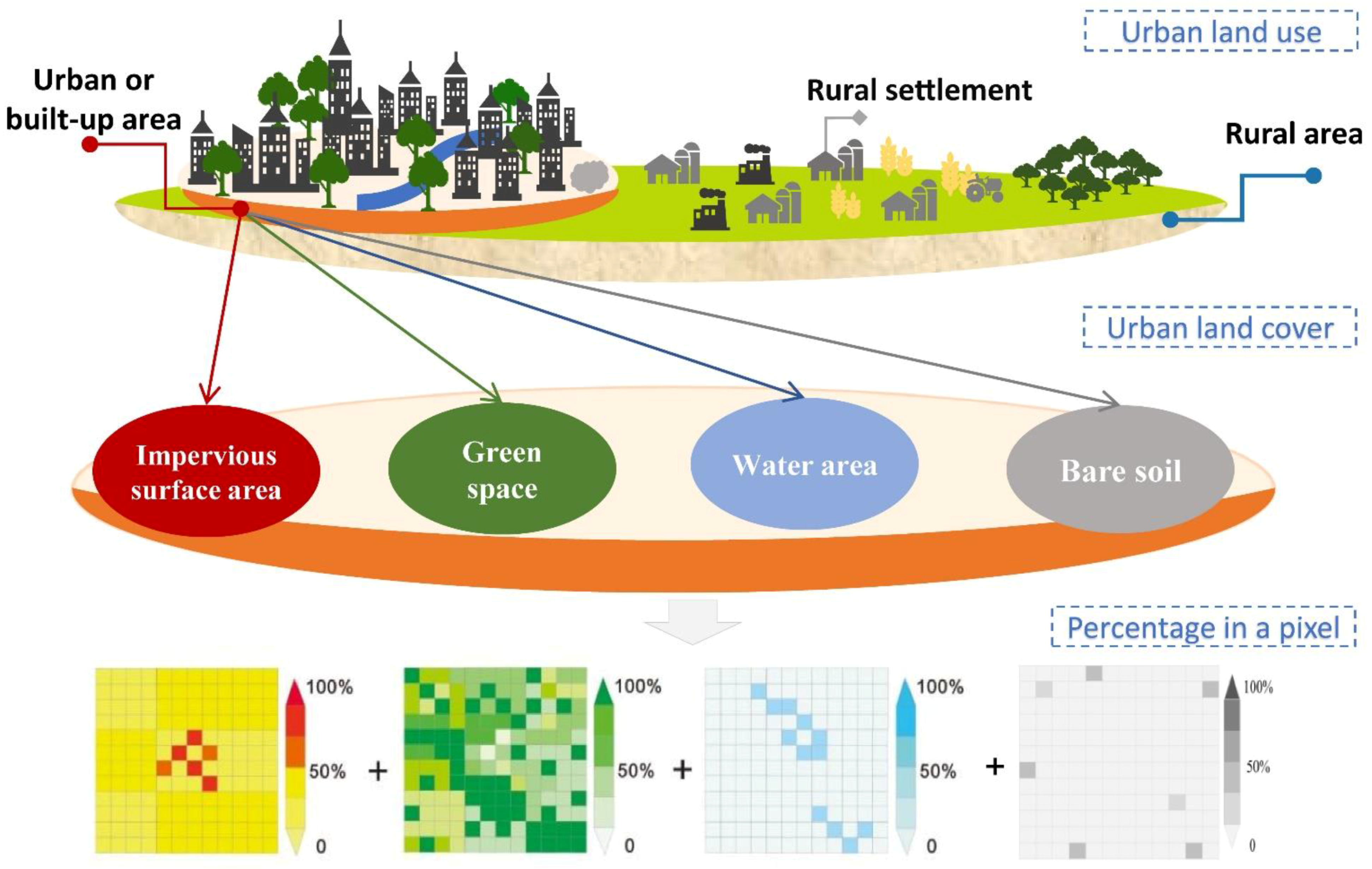
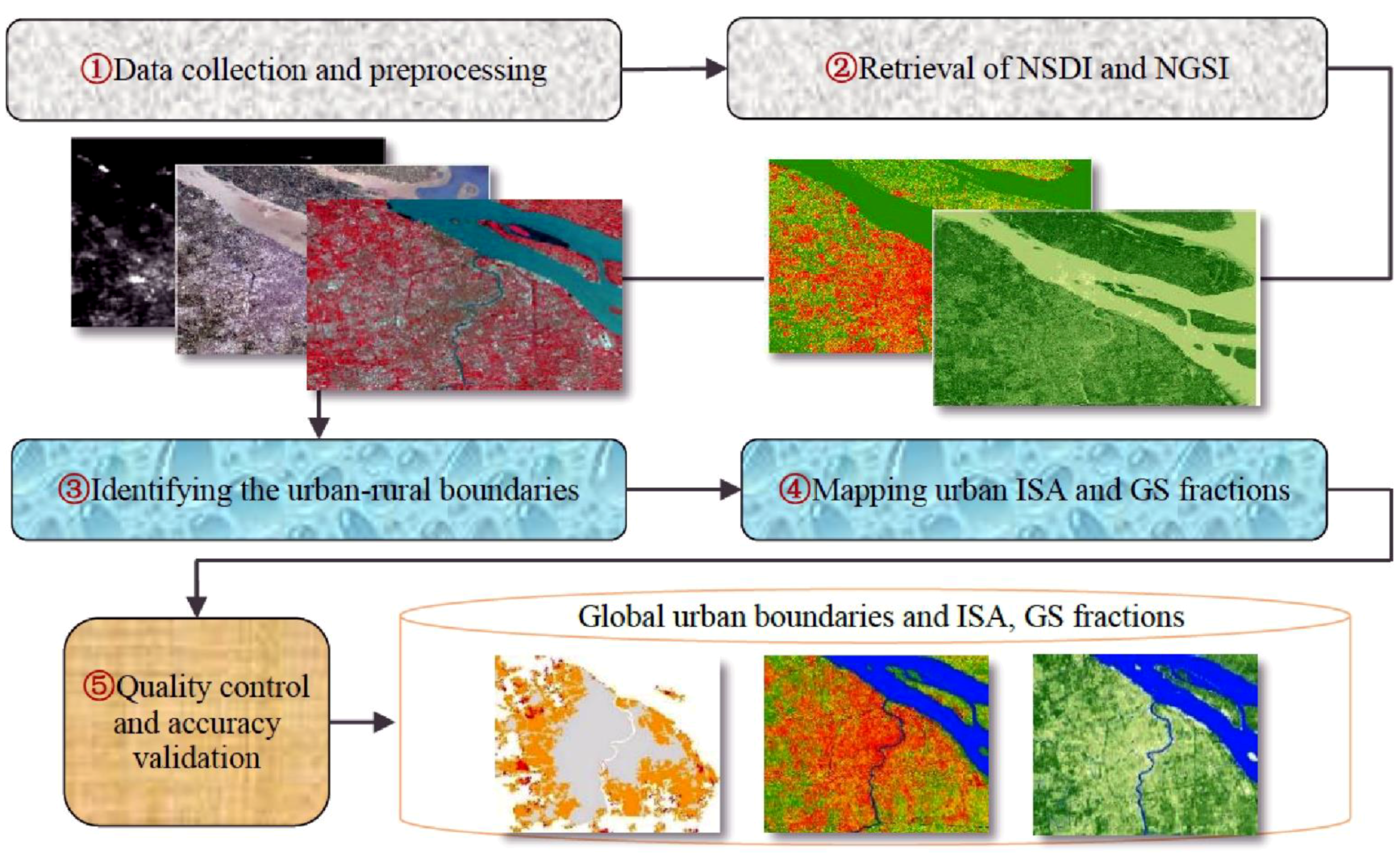

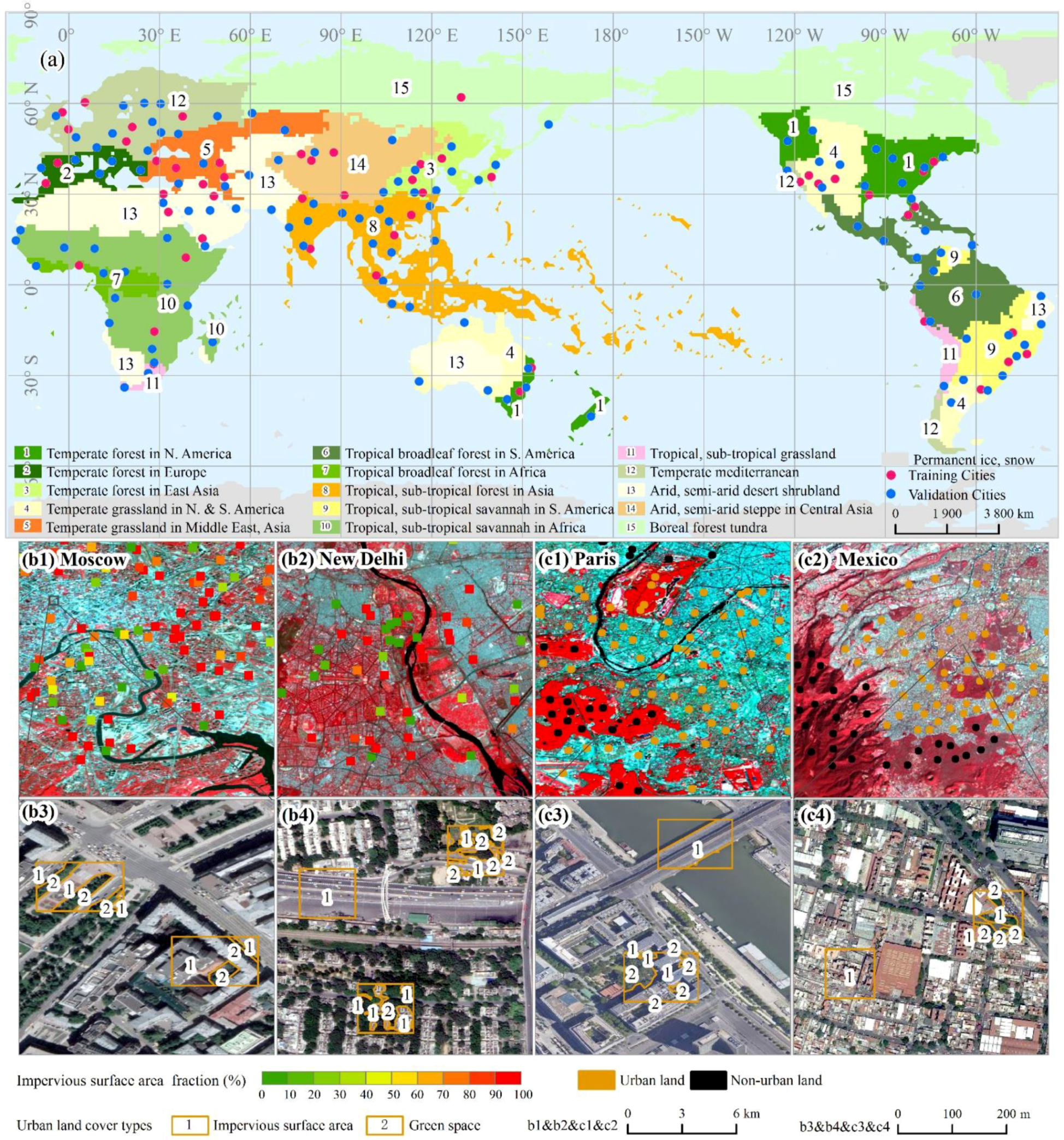
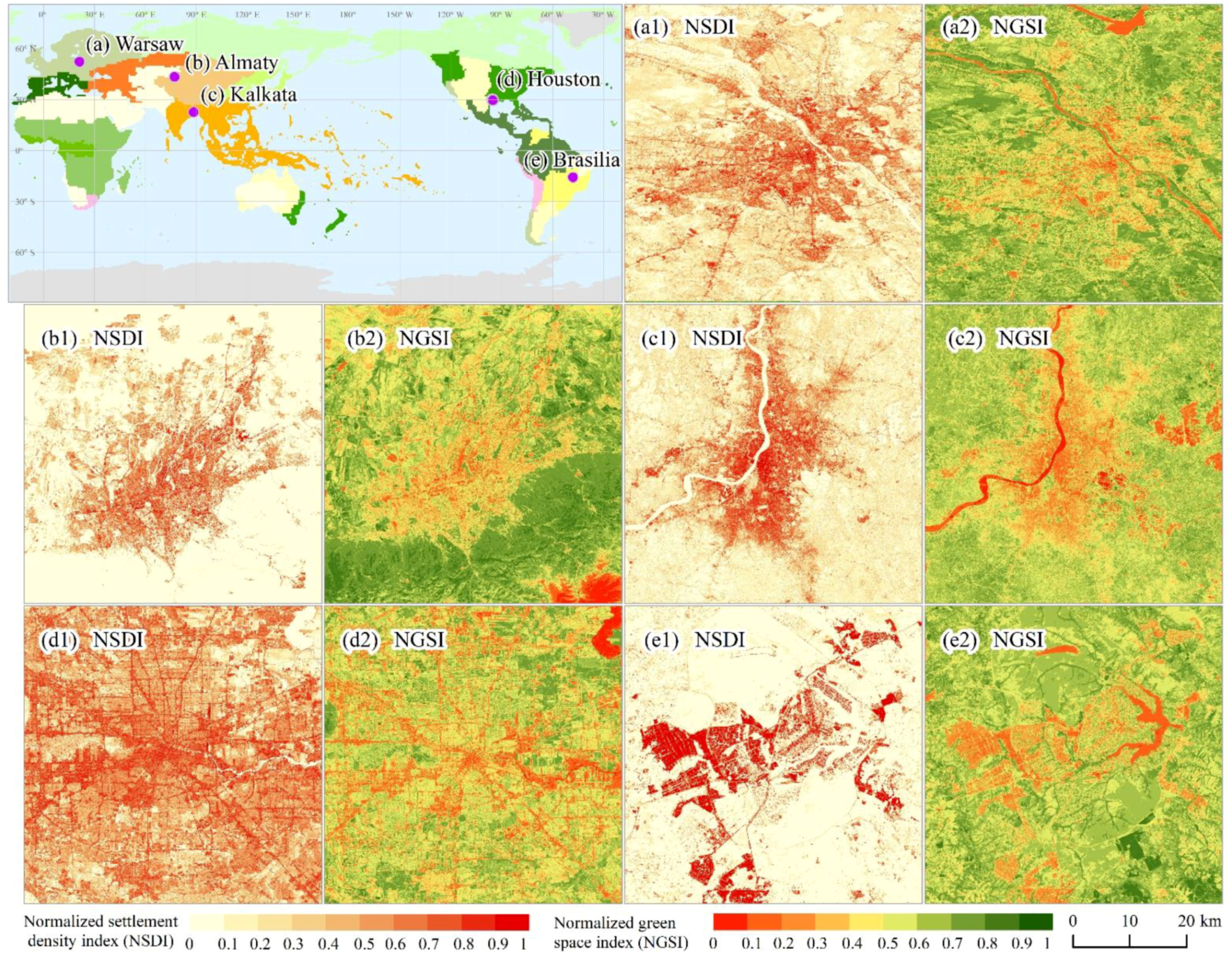

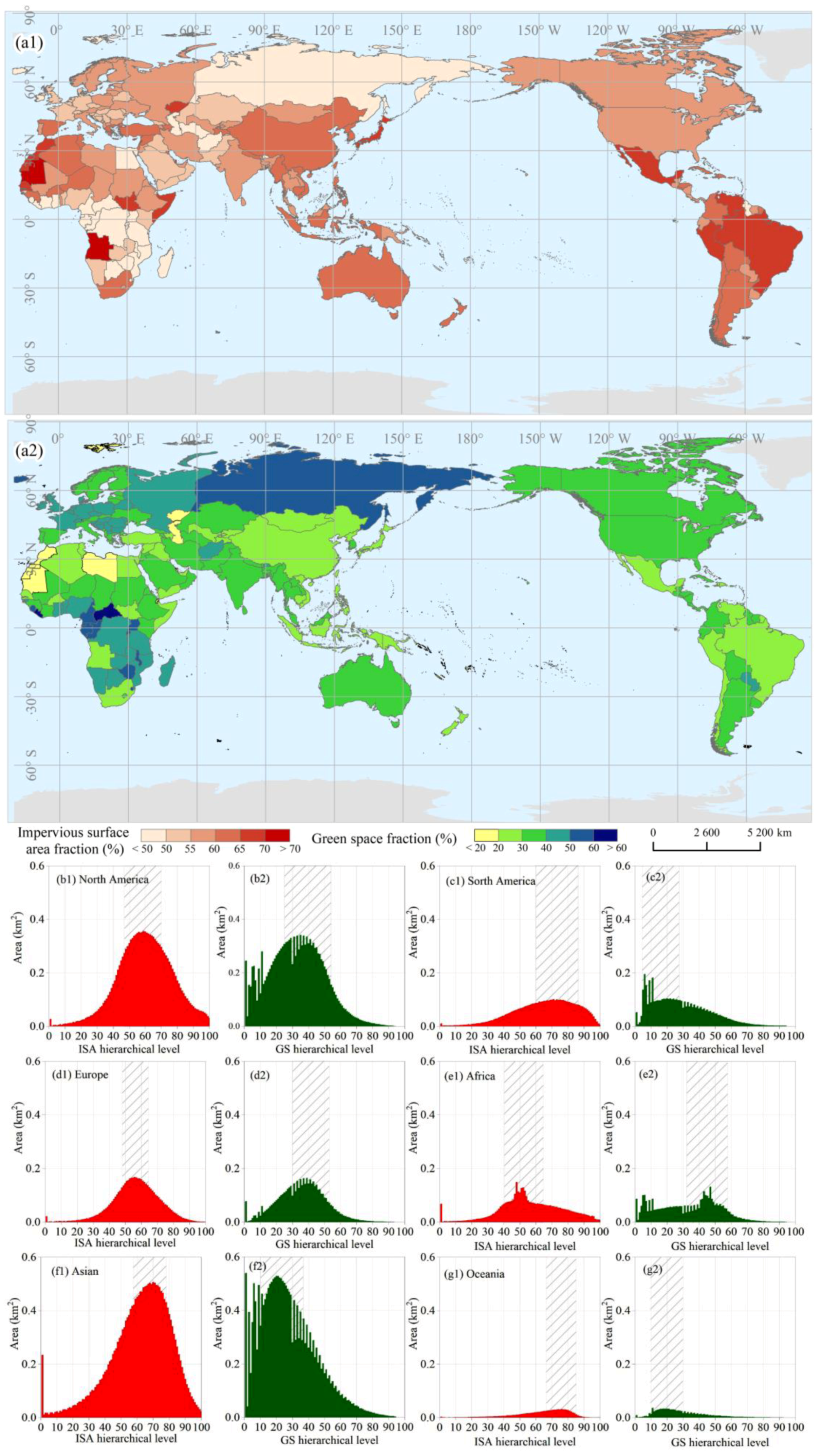
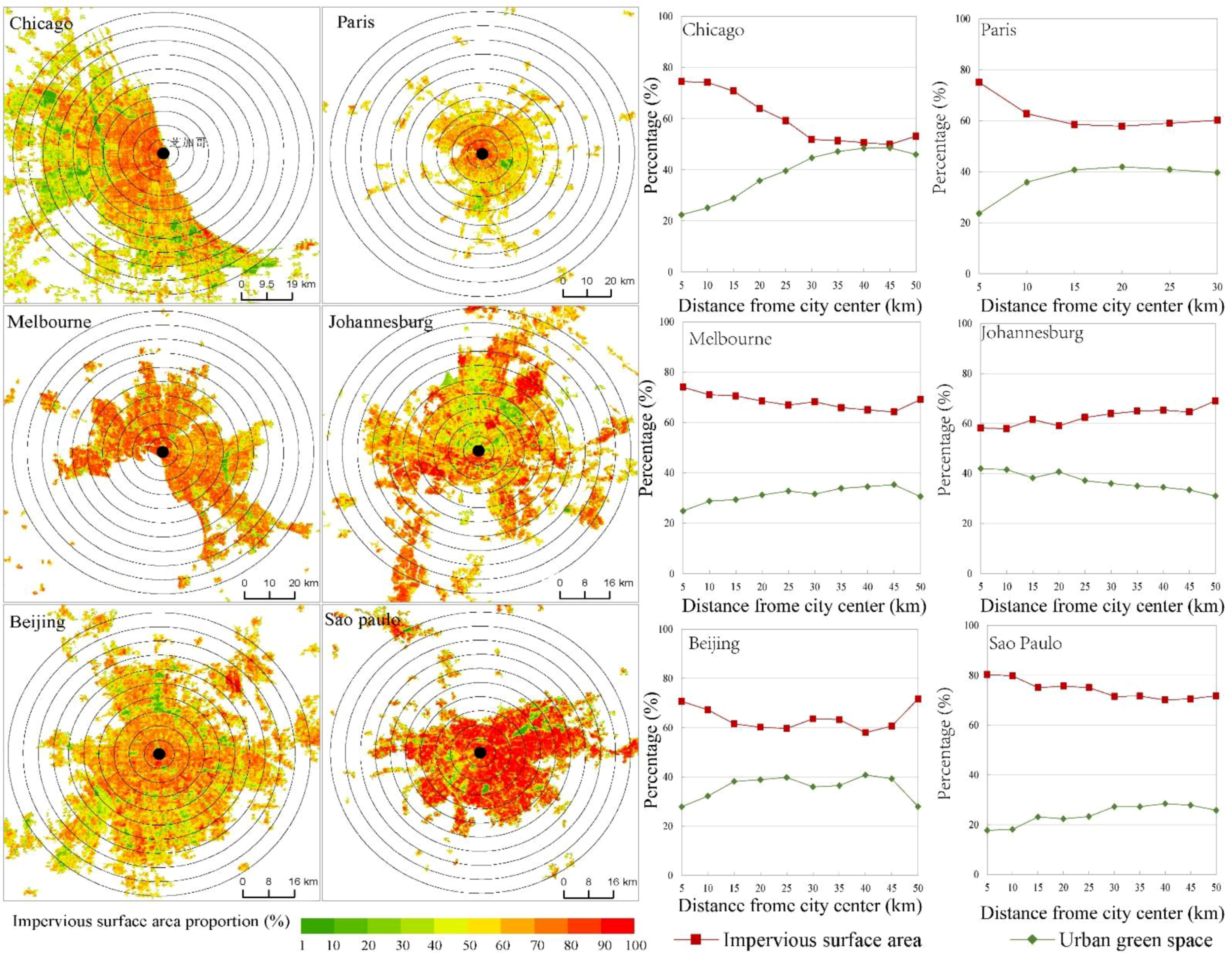
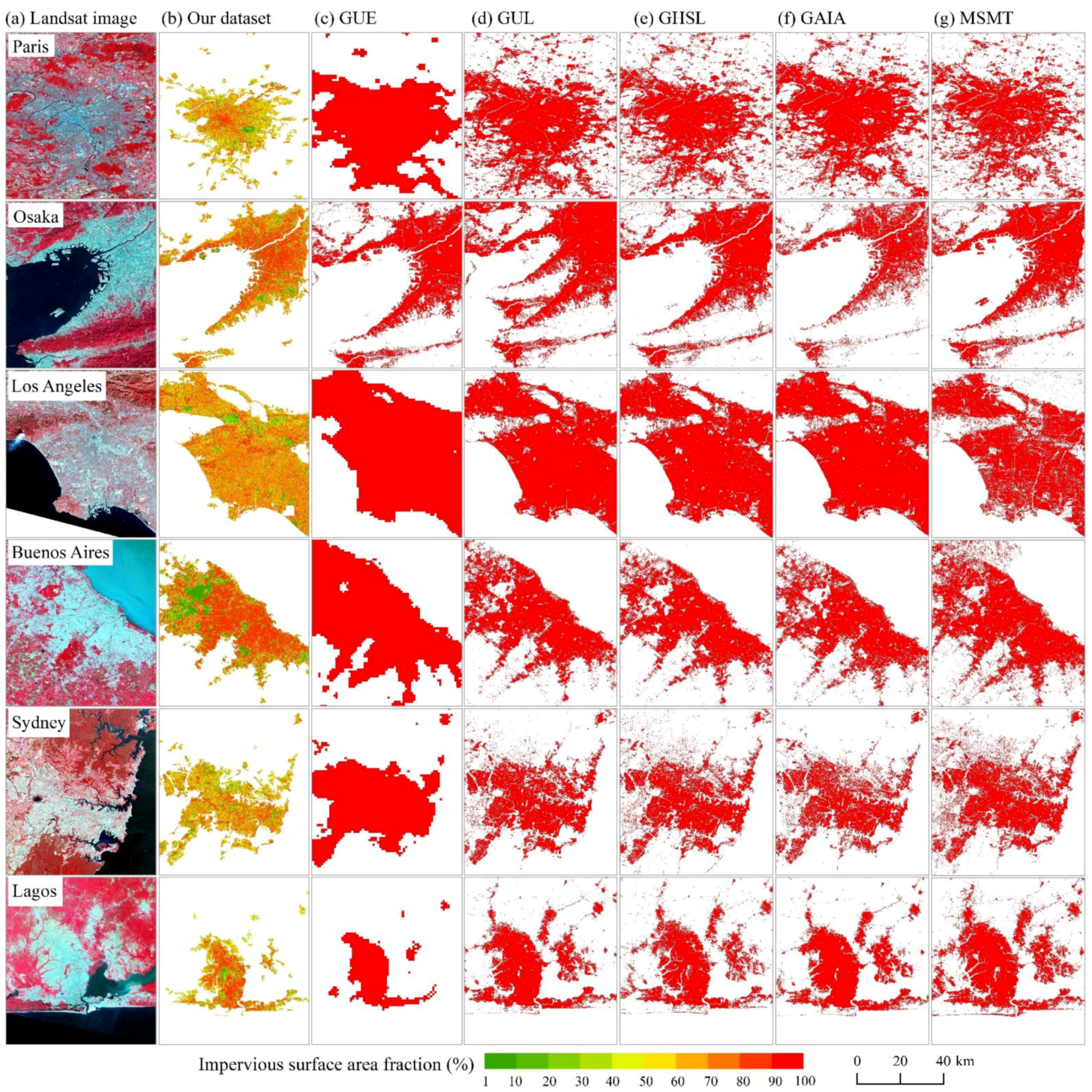
| Data Source | Resolution | Scene/Extent | Covered Period |
|---|---|---|---|
| Landsat 8 OLI | 30 m/15 m | 146,878 | 1 January 2015–31 December 2015 |
| Landsat 8 OLI | 30 m/15 m | 160,659 | 1 February 2019–31 January 2020 |
| SRTM Digital Elevation | 30 m | Global | -- |
| Google Earth images | 0.6 m | 865 | 2015 and circa 2020 |
| Gaofen-2 (GF-2) | 4 m/1 m | 536 | Circa 2020 |
| Global surface water | 30 m | Global | 2015 and circa 2020 |
| DMSP/OLS | 1 km/500 m | Global | 2015 and circa 2020 |
| 2015 | Circa 2020 | |||||||
|---|---|---|---|---|---|---|---|---|
| Index | PA (%) | UA (%) | OA (%) | Kappa | PA (%) | UA (%) | OA (%) | Kappa |
| Asia | 90.19 | 90.58 | 90.38 | 0.900 | 91.19 | 91.98 | 91.58 | 0.832 |
| Europe | 91.22 | 93.10 | 92.15 | 0.926 | 90.56 | 91.64 | 91.10 | 0.822 |
| North America | 91.33 | 92.40 | 91.86 | 0.837 | 91.60 | 92.60 | 92.10 | 0.842 |
| South America | 91.30 | 92.84 | 92.07 | 0.868 | 91.45 | 93.19 | 92.31 | 0.864 |
| Africa | 90.20 | 91.92 | 91.05 | 0.855 | 90.49 | 91.12 | 90.80 | 0.849 |
| Oceania | 91.15 | 91.62 | 91.38 | 0.864 | 91.03 | 91.86 | 91.44 | 0.857 |
| Global | 90.78 | 92.03 | 91.40 | 0.870 | 91.11 | 92.15 | 91.63 | 0.860 |
| 2015 | Circa 2020 | |||||||
|---|---|---|---|---|---|---|---|---|
| Data Type | ISA | GS | ISA | GS | ||||
| Index | R | RMSE | R | RMSE | R | RMSE | R | RMSE |
| Asia | 0.93 | 0.14 | 0.93 | 0.14 | 0.94 | 0.12 | 0.93 | 0.11 |
| Europe | 0.93 | 0.16 | 0.93 | 0.13 | 0.94 | 0.15 | 0.94 | 0.16 |
| North America | 0.94 | 0.13 | 0.93 | 0.14 | 0.94 | 0.13 | 0.92 | 0.14 |
| South America | 0.93 | 0.03 | 0.92 | 0.08 | 0.93 | 0.03 | 0.93 | 0.11 |
| Africa | 0.92 | 0.15 | 0.91 | 0.18 | 0.92 | 0.13 | 0.91 | 0.12 |
| Oceania | 0.93 | 0.14 | 0.92 | 0.15 | 0.94 | 0.08 | 0.92 | 0.10 |
| Global | 0.93 | 0.13 | 0.92 | 0.14 | 0.94 | 0.11 | 0.93 | 0.12 |
Publisher’s Note: MDPI stays neutral with regard to jurisdictional claims in published maps and institutional affiliations. |
© 2021 by the authors. Licensee MDPI, Basel, Switzerland. This article is an open access article distributed under the terms and conditions of the Creative Commons Attribution (CC BY) license (https://creativecommons.org/licenses/by/4.0/).
Share and Cite
Kuang, W.; Hou, Y.; Dou, Y.; Lu, D.; Yang, S. Mapping Global Urban Impervious Surface and Green Space Fractions Using Google Earth Engine. Remote Sens. 2021, 13, 4187. https://doi.org/10.3390/rs13204187
Kuang W, Hou Y, Dou Y, Lu D, Yang S. Mapping Global Urban Impervious Surface and Green Space Fractions Using Google Earth Engine. Remote Sensing. 2021; 13(20):4187. https://doi.org/10.3390/rs13204187
Chicago/Turabian StyleKuang, Wenhui, Yali Hou, Yinyin Dou, Dengsheng Lu, and Shiqi Yang. 2021. "Mapping Global Urban Impervious Surface and Green Space Fractions Using Google Earth Engine" Remote Sensing 13, no. 20: 4187. https://doi.org/10.3390/rs13204187
APA StyleKuang, W., Hou, Y., Dou, Y., Lu, D., & Yang, S. (2021). Mapping Global Urban Impervious Surface and Green Space Fractions Using Google Earth Engine. Remote Sensing, 13(20), 4187. https://doi.org/10.3390/rs13204187








